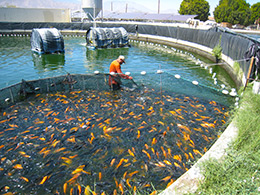TILAPIA

- Less than 10 percent of tilapia consumed in the U.S. is farmed domestically.
- Tilapia sales have exceeded those of trout in the U.S. each year since 1995.
- These fish are herbivores feeding mainly on plankton, filamentous algae, aquatic macrophytes and other vegetable matter. As a result, tilapia do not accumulate pollutants and other toxins in their bodies.
- This tropical fish is a good candidate for farming, because it produces more protein than it takes to raise it, in contrast to some other fish raised in farms, such as salmon or tuna.
Native to North Africa, tilapia is a hardy, prolific freshwater fish that tolerates a wide range of water conditions. Originally found throughout the African continent and much of the Middle East, Tilapia live in the shallow, turbid waters of rivers and lakes. These fish are herbivores feeding mainly on plankton, filamentous algae, aquatic macrophytes and other vegetable matter. As a result, tilapia do not accumulate pollutants and other toxins in their bodies. This tropical fish is a good candidate for farming, because it produces more protein than it takes to raise it, in contrast to some other fish raised in farms, such as salmon or tuna. Although tilapia can live in either fresh or salt water, most species are unable to survive at temperatures below 50°F.

